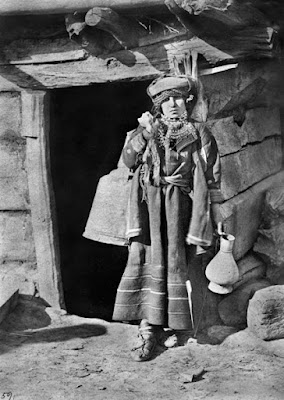„არჴამინ“ -„Arqhamin“: Taboo against the Repetition of lamenting Songs
The Tushetian word „არჴამინ“ -„Arqhamin“ can be translated as „prohibition“. It refers to the constraint imposed by social custom or as a protective measure. The word is although also used specifically as a taboo against the repetition of the ritually enacted "Lament in Voice" song. It was inhibited to memorize and reproduce the singing, that was performed in the context of the death ritual. The taboo of „Arqhamin“ regulated the encounterings with the "extraordinary". The once performed lament, that the "Lamentor in Voice" opened the doors to the dead with, ought to be unique to the moment, and never be repeated,1 neither in a different setting nor at a different time, neither by the same nor by another lamentor.2
The Tushetian folklorist Eter Tataraidze understands "Arqhamin" as a gesture of awe towards death: „To not remember [the laments], out of awe towards death, that is Arqhamin“3. According to Tataraidze, there was a belief in Tusheti, that the repetition of the lament of the "Lamentor in Voice" would bring mischief or some kind of inadvertent death. The contact with the dead was therefore ritually tamed.
It is characteristic of rituals to set a boundary. The ritual defines a beginning and an end and provides thus a frame for encountering such emotionally and psychologically charged phenomena like death, grief, or loss. The ritual establishes a threshold between the "mundane life" and creates a space for safer encounters.
The prohibition "Arqhamin" - not to approach the realm of the dead - was suspended during the time and in the space of the death ritual. The ritual was a temporarily opened door to the realm of the dead. It was the job of the "Lamentor in Voice" to support, with her voice, the dynamic between the river of death and life and the emotional flow of the participants. In this way, the individual pain could be shared and experienced as a collective sorrow, that was connected to the broader river of evanescence. In the process, the "Lamentor in Voice" was not the one, who created the flow, but the person, who allowed through her voice, emotional channels to be harmonically (or dis-harmonically) connected. Thus the music and the words generated in this context were creations of the moment, that could not have been held on to. As integral parts of the broader evanescing dynamic, they were elusive and fading as their river ally.
The "Arqhamin" marked the ritual boundaries and ensured, that the practices would be enacted within a frame, that was distinct from other moments and happenings in life.
1. აზიკური: მგოსანნი გლოვისანი, გვ. 6./ Azikuri: Mgosanni Glovisani, P. 6.; კიკნაძე: ქართული ფოლკლორი, გვ. 309./ Kiknadze: Kartuli Folklori, P. 309.
2. There were some exceptions to the rule against the repetition of lamenting songs: 1. In Tuscheti it was used to murmur the laments quietly whilst being alone at home and doing crafts, like weaving or knitting. This act had a name on its own and was called „Zuzuni“. (In: აზიკური: მგოსანნი გლოვისანი, გვ. 8./ Azikuri: Mgosanni Glovisani, P. 8.) 2. In Khevsureti, there was a custom, of scything the first meadows in springtime, in a ritual manner, whilst singing "Lament in Voice" songs. This ritual was called "Gvrinva" and was performed by men-gendered people in a choir manner. Those kinds of songs were called "Gvrini". In: ჩიტაია: მასალები საქართველოს ეთნოგრაფიისთვის, გვ. XIII / Chitaia: Masalebi Saqartvelos Etnograpiistvis, P. XIII.; I write about the ritual of "Gvrinva" in more detail in this post: https://georgianlamentation.blogspot.com/2021/07/gvrini-georgian-scything-song-for-dead.html
3. „სიკვდილის შიშით არ დამახსოვრება, აი ეგ არის არჴამინი“ From an interview with Eter Tataraidze.


Comments
Post a Comment